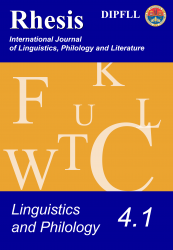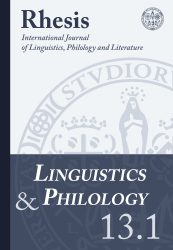 Linguistics and PhilologyVol. 4.1 - 2013
Linguistics and PhilologyVol. 4.1 - 2013Table of contents
| p. 5 | ForewordGabriella MazzonArticle |
| p. 6 | I’m loving you – and knowing it too: Aspect and so-called stative verbsSolveig Granath, Michael Wherrity Abstract English verbs are generally classified as either stative or dynamic, where one of the main differences is said to be that stative verbs are inimical to the progressive aspect. Cases where such verbs do occur in the progressive are often explained away as involving a change in verb meaning. Another common approach to the progressive is to maintain that the progressive form as such can convey a range of meanings. Most commonly, a distinction is made between progressives with aspectual meaning and progressives with subjective meaning. In the present paper we take a functional-semantic approach and argue that all socalled stative verbs can potentially be used in the progressive. We further argue that the grammatical morpheme –ing has a synchronically invariant core meaning which can be pressed into service via the progressive construction to evoke a variety of messages – aspectual and expressive – depending on the context and the communicative needs of the speaker. The data used in the present paper are 132 tokens of BE loving and 66 tokens of BE knowing from the Corpus of Historical American English. Our results suggest that one reason verbs such as these are said to be inimical to the progressive is because this usage is primarily a feature of spoken language, and most grammatical descriptions up until recently have been based on written English. |
| p. 23 | ALWAYS-progressives in early American EnglishGabriella Mazzon Abstract One of the contexts of expansion of progressive forms in Late Modern English (along with others that were later equally, or even more, successful; see e.g. Fitzmaurice 2004; Smitterberg 2005; Nesselhauf 2007) is the habitual – iterative context, in which the form co-occurs with always and other markers of iterativity or continuity such as constantly, every day, etc., and often convey expressive pragmatic values such as irritation, impatience, and the like. This context is nowadays quite common, although it stands in contrast with the “progressive” core meaning. The precise conditions for its spread and constraints on its occurrence, however, are still debated (e.g. Killie 2004, Kranich 2007, 2008), and not much has been ascertained about its distribution. |
| p. 40 | The (Un)Reality of the Perfect Infinitive, Reconsidered from a Constructional PerspectiveElisabeth Senft Abstract Due to great diachronic as well as synchronic variation and change, the perfect aspect has been studied to a great extent. In English, its infinitival form (have + past participle) has been largely neglected, however. This paper therefore seeks to explore ‘non-core’ grammatical constructions of the type Vpast; + perfect infinitive, especially their function and use in BNC, COCA and COHA. It challenges previous explanatory attempts by arguing that the perfect infinitive in the environments discussed does not indicate counterfactuality, as commonly believed. Instead, by taking a constructional perspective, the use of the perfect infinitive is argued to be a case of anteriority agreement, whereby speakers feel the urge to place the proposition on the same temporal level as the matrix verb. The findings of the corpus-based study further suggest that perfect infinitive constructions are in decline and might be in the process of disappearing from English altogether. Thus, this article attempts to extend the discussion of the perfect aspect to one of its non-finite forms but at the same time provides further implications for explaining recent change of the perfect aspect in general. |
| p. 65 | Communicating Europe: a social semiotic approachAntonio Piga Abstract The failure of the referenda in France and the Netherlands in May and June 2005 plunged the EU into its deepest and most serious crisis since its foundation. During the ‘period of reflection’ declared by the European Council in June 2005, EU institutions clearly recognized the need to understand this lack of democratic legitimacy in terms of communicative action, thus paving the way ‘to close the gap’ with citizens and face this sense of alienation felt from Brussels. In addition, the recent trend of globalization has had a great impact on a variety of different domains; the result being that the contemporary world has been fostering the formation of a corporate-model to increase profit-making opportunities. The paper sets out to investigate the diachronic changes of the rhetorical and pragmatic linguistic strategies from the point of view of «the key dimensions of social semiotics» (van Leeuwen 2005: 91), namely discourse, genre and style, and uncover displacement of «communicative» practices with «strategic action» (Habermas 1987: 333), which in turn entails a purely instrumental rationale. In particular, EU discourse pre- and post- the referendum fiasco is investigated in terms of how it constructs representations of the social world and the EU political and institutional process itself; how it contributes as a means of EU institutional process; and how it conveys a particular EU identity connected to particular values. |
| p. 94 | Book Review - Testifying to Language and Life in Early Modern England, by Merja Kytö, Peter J. Grund and Terry WalkerStephan Giuliani Abstract Merja Kytö, Peter J. Grund and Terry Walker. Testifying to Language and Life in Early Modern England. Amsterdam/Philadelphia: John Benjamins, 2011. ISBN: 978-90- 272-1180-4. Hardback + CD-ROM |
Tags: adverbs, American English, Antonio Piga, aspect, be to, constructions, corpus, corpus linguistics, critical discourse analysis, discourse, Elisabeth Senft, Gabriella Mazzon, genre, infinitival perfect, Michael Wherrity, pragmatics, progressive, social semiotics, Solveig Granath, stative verbs, Stephan Giuliani, style

